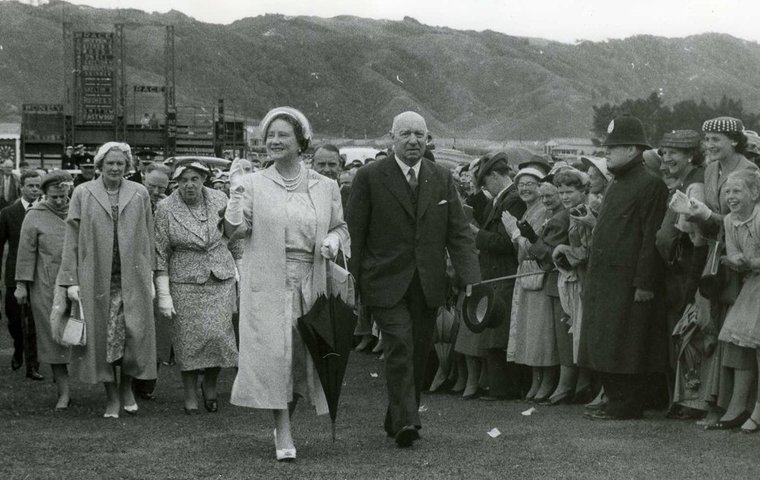
Choisir gave the mighty Phar Lap a nudge as a pioneering antipodean when he won both the King’s Stand and Golden Jubilee Stakes in the same week at Royal Ascot in 2003.
Much was made of the remarkable achievement of the impressive chestnut trained by Paul Perry in New South Wales shipping halfway around the world to triumph in the two biggest sprint races at Britain’s showcase fixture.
And rightly so. Choisir was a special horse, of that there is no doubt. He had been placed in the G1 Caulfield Guineas and won the G1 Lightning Stakes in Melbourne, and he then campaigned adventurously in Britain, winning twice at the Royal meeting before finishing second to Oasis Dream in an epic G1 July Cup at Newmarket. He deserved the accolades.
He blazed a trail also followed by Takeover Target, Miss Andretti, Scenic Blast, Black Caviar, and in an indirect way, So You Think and, more recently, Merchant Navy — all winners at the meeting with Australasian origins.
A race in Her Majesty’s honour
This year, trainer Michael Pitman has brought Enzo’s Lad from New Zealand for the G1 King’s Stand, but, if successful, the gelding may not lay valid claims to being the first Kiwi horse to bask in Royal Ascot glory.
In fact, this is the 60th anniversary of one of the most extraordinary tales of Royal success at Ascot, and unusually, the horse in question, the New Zealander Bali Ha’i, carried the colours of HM Queen Elizabeth, the Queen Mother, whose horses mainly ran over jumps.
To fully appreciate the story, let us go back to 1958, when the Queen Mother is attending a special race meeting at Trentham racecourse, outside Wellington, at which the St James (sic) Cup is run in her honour as a one-off.
The race is won by Bali Ha’i, a promising half-brother to the 1949 Melbourne Cup winner Foxzami, trained by Tom and Ray Verner, and ridden by New Zealand’s top jockey, Grenville Hughes.
Bali Ha’i carries the colours of brewery tycoon Sir Ernest Davis, a former mayor of Auckland and four-times leading owner, who at the official presentation of trophies stuns the Queen Mother — and the crowd — by asking Her Majesty to accept the horse “as a gift from the sporting people of New Zealand”.
This set up an amazing Royal racing story featuring one of the first internationals from Down Under in the modern era.
On April 22, 1958, Bali Ha’i arrived at the Royal Docks, London, and was transported to Newmarket to join the stable of Sir Cecil Boyd-Rochfort.
Given time to acclimatise in his new surroundings, Bali Ha’i came into his own in 1959, running with credit at the Chester May meeting before winning at Sandown Park in the hands of top lightweight Willie Snaith.
‘An element of danger’
Bali Ha’i was sent off 15/8 favourite for the Queen Alexandra Stakes, and, ridden by Harry Carr, he defeated three rivals for a famous Royal victory in the colours of the Queen Mother and a dream result for New Zealand.
Sir Michael Oswald, former racing manager to the Queen Mother, was fully aware of the gamble such an international adventure entailed in the late 1950s.
“Obviously, it was a long, long time ago, and in those days it was often a very difficult journey by ship to England lasting many weeks. Now, they fly horses all over the place and they seem perfectly happy when they arrive at their destination.
“Being publicly given a horse as a gift, I suppose there was an element of danger that the horse may have been no good, and that could have caused embarrassment. But Bali Ha’i did his part by winning the Queen Alexandra, the longest race at the meeting.
“Queen Elizabeth, the Queen Mother, did not have many runners at Royal Ascot. She went in for steeplechasers and hurdlers, so she was more Cheltenham and Aintree. Most of her runners on the flat were horses getting ready for a jumping career,” he pointed out.
Bali Ha’i, however, never raced over jumps. He suffered a tendon injury in 1960, and, while he raced twice the following year, his best racing days were behind him. He was retired and repatriated to New Zealand, where the Queen Mother was able to see him on a subsequent visit to the country in 1966.
Phar Lap, the New Zealand-bred, Australian-trained 1930 Melbourne Cup hero, who won 37 of his 51 starts, became an international legend when he was shipped across the Pacific to Tijuana, Mexico, where on the March 20, 1932, he won the Agua Caliente Handicap, then promoted as the world’s richest race.
He died 16 days later of arsenic poisoning.


